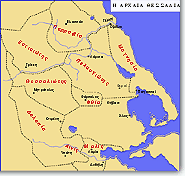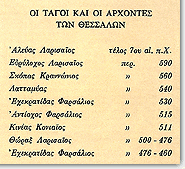

According to Thucydides, the Thessalians occupied the land that bore their name sixty years after the Trojan War. Aleuas I of Larisa, the first tagos of the region, divided it into four parts, the so-called tetrades: Thessaliotis, Pelasgiotis, Histiaeotis, and Phthiotis. Heading the tetrades were families such as the Aleuadae of Larisa; the Scopadae of Crannon; and the Echecratidae of Pharsalus. He also laid down that in time of war each family should provide forty horsemen and eighty peltasts. Initially the tagos was appointed commander of the army in wartime. But in many instance he retained this power for life. The previous inhabitants left the country, and those who remained formed a group called, in the central plain, penestae, or, in Perraebia, Magnesia, and |  |
 | The gradual concentration of power in the hands of the tagos is perhaps to be linked with the involvement of Thessalians in the political affairs of central Hellas. In the late 8th century B.C. Cleomachus of Pharsalus took part, fighting for the people of Chalcis, in a battle in the Lelantine War. The intervention of the Thessalian cavalry can perhaps be explained by the ties of xenia that bound the Echecratidae to the family of Amphidamas of Chalcis. But it is also perhaps a first indication of the Thessalians' inclination to extend their influence. After annexing Aenis and Malis, moreover, the Thessalians won a majority on the Amphictyony of Anthela, which had as its centre the temple of Demeter. This attempt becomes more obvious after the 1st Sacred War in the mid-6th century B.C. But gradually, in the context of the Thessalian League, the cities started to mint coins, an indication of their gradual autonomizing in relation to the League. In the 5th century B.C., the city leaders mentioned are the epestakon tagos and the hylorus (the forester responsible for the city's environs). Probably only the agathoi had civic rights: these were the landowners who had no need to work. The Assembly of the demos, if such even existed, must have had very restricted competence. |
|
| |
|
Note: Click on pictures to see a short description. | |